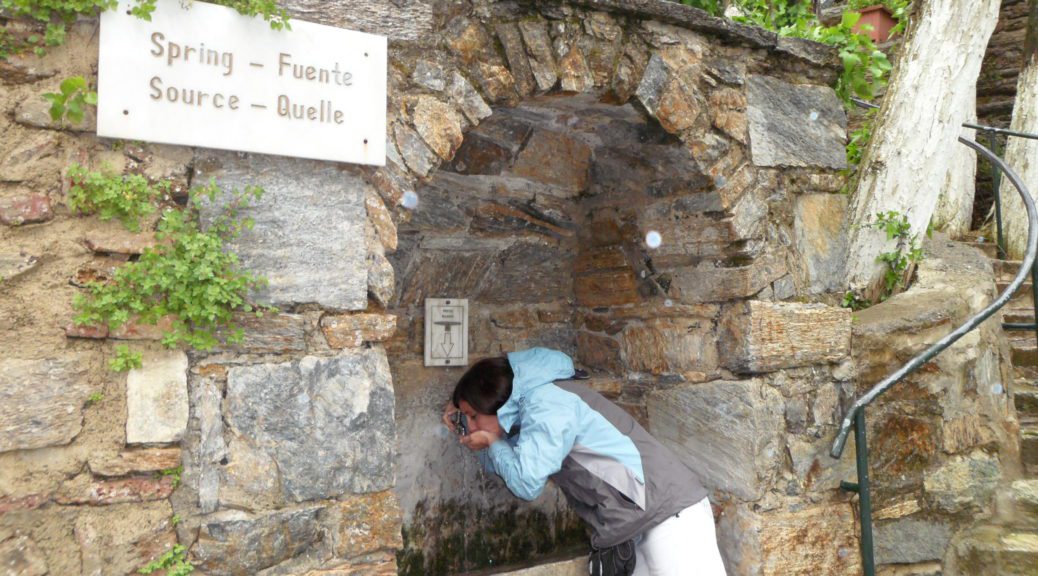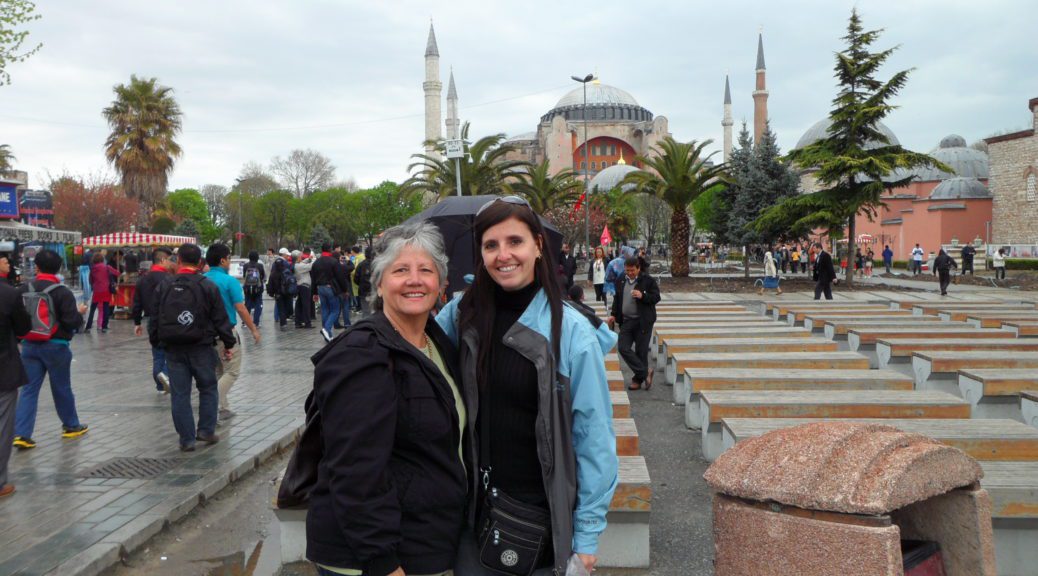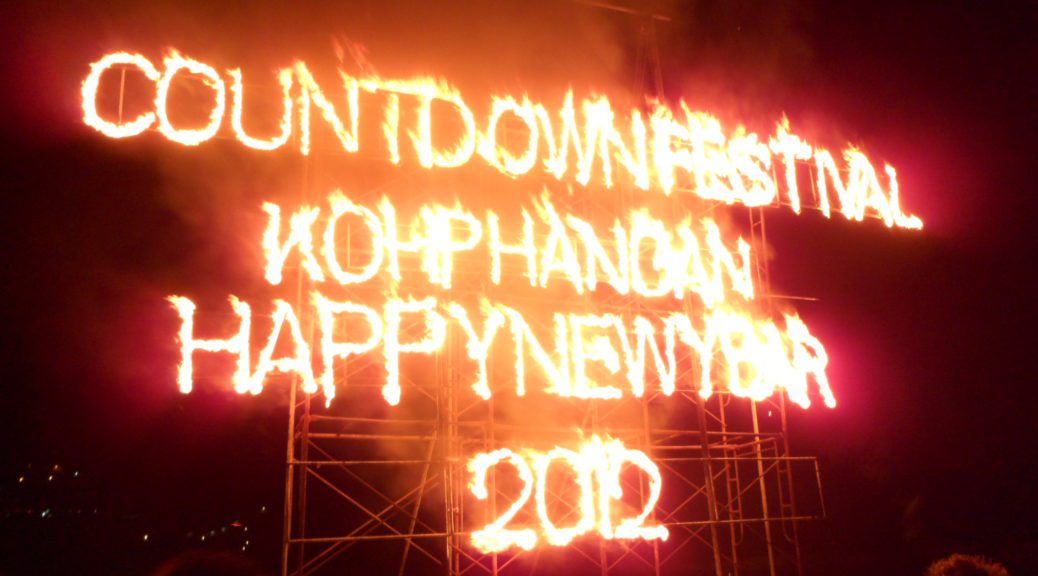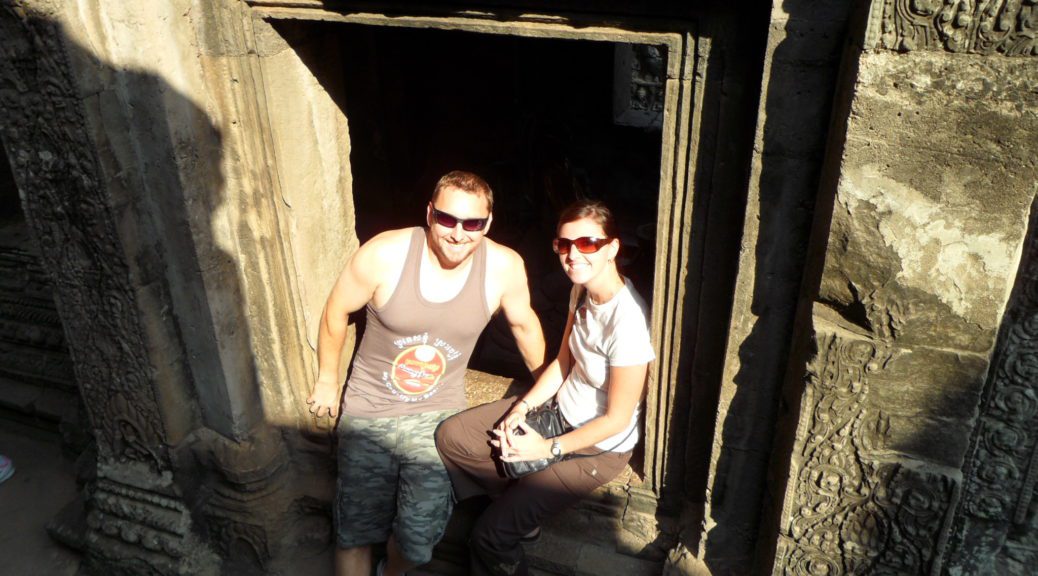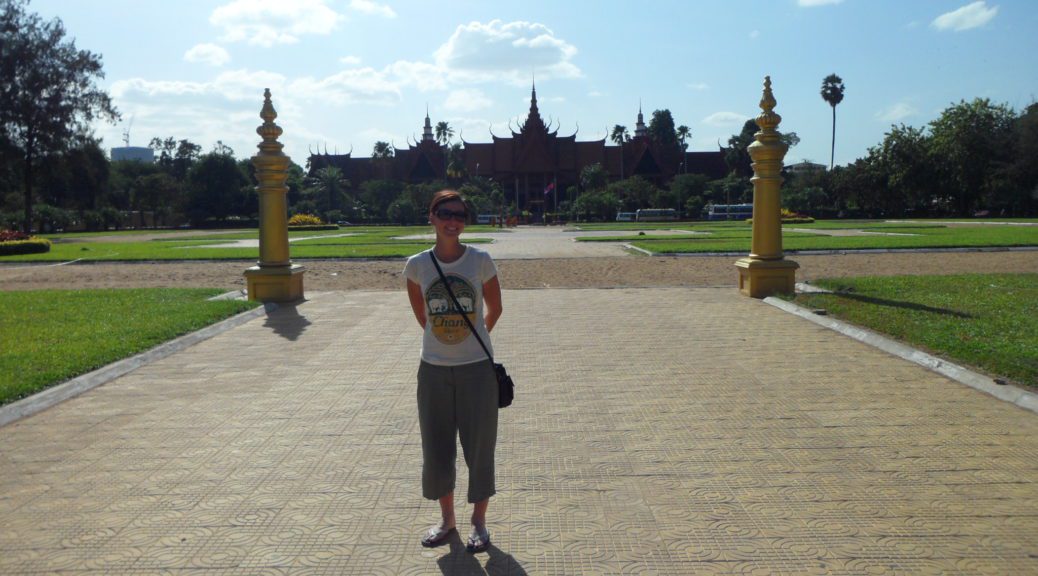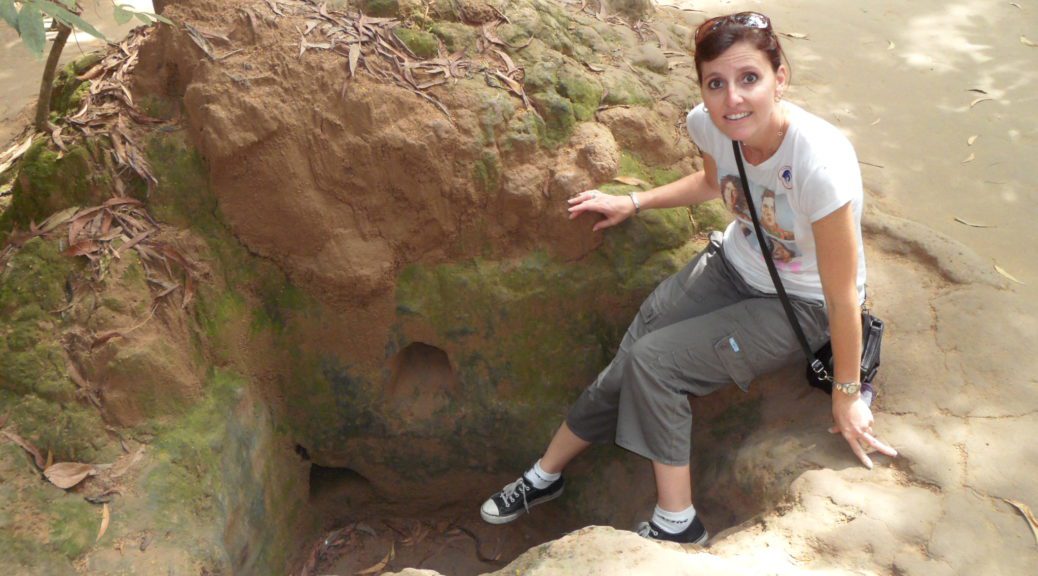KUSADASI
18 April 2012
Kusadasi – pronounced “KOO-SHA-duh-suh” (the first half pronounced and the second half swallowed) and translated as “Bird Island” – is the biggest port in Turkey. The district gets its name from the Guvercin (Dove) Island facing it, home of a Byzantine castle carved into the rock and the 19th century Kucuk Ada Castle which were important defence points against pirate raids during the Ottoman Period.
We found ourselves deposited unceremoniously roadside by the bus as it arrived in Kusadasi on Monday night at 21h00. 2 South Africans, 2 Australians, 4 suitcases, 3 togbags, 1 map (of Istanbul) and a bus steward who spoke Turkish and Japanese, but no English. Challenge.
We showed the hotel name written on our itinerary to the locals milling nearby and were relieved at their lack of hesitation and pointing gestures which seemed to indicate that they knew where we were going and it was (literally) just around the corner.
Around the corner we trooped. And down the hill. And down the hill some more.
We stopped and asked a shopkeeper, again using the itinerary to show hotel name, and again he immediately responded, pointing in the same direction as we’d been headed, adding “50 metre! 50 metre!”. Sounded promising.
Some half a kilometre later (fortunately all downhill and all the while silently applauding the inventor of trolley cases), we saw the big red neon sign than announced our hotel. And very lovely 4* at that. Hallelujah.
Eager for more leg-stretch (sans luggage) after the afternoon in the bus, we headed out to see what Kusadasi had on offer.
The hotel was well situated for entertainment, being just a few blocks up from the waterfront and near the bazaars (closing 11pm). The nightlife was quite active, starting with the hotel’s patio which was teeming with travellers (an Italian tour group).
We soon tired though and headed back to the hotel to retire (with the chocolate mousses we’d salvaged from the hotel’s dinner buffet that was closing as we arrived).
WEDNESDAY
Another boring continental breakfast buffet. This had the same selection of 5 cereals (cornflakes, coco pops, muesli, chocolate flakes and puffed wheat, which also seemed to be the only cereals stocked in supermarkets we’ve been to!), jams, cheese, polony, eggs and bright pink viennas. This buffet did however add 5 different types of olives (excessive much?) and had bowls around the yoghurt (there’s only ever original unflavoured yoghurt that we’ve seen) with halva, syrup, strawberry jam etc which leads one to believe that one can flavour one’s own yoghurt should one choose. One didn’t (and neither did the other one).
The tour bus arrived more or less on time (remarkable) and had a mix of new people. The tour groups here seem to fluidly combine and separate, ostensibly so anyone from anywhere can choose their own custom package while still enjoying group rates. Sometimes this arrangement shows false economies though, for example there was one lady who’d travelled through that morning from Izmir, which we’d passed through at about 19h00 the night before. It might have made more sense for us to stop for the night in Izmir, giving us a more reasonable check-in time and better evening options (as well as a chance to see the sights of Izmir since it only gets dark well after 8). We could then all have been collected together the next morning.
Similarly, she was moving straight on to Pamukkale after the previous day’s tour, where we stayed in Kusadasi the previous night and were going to Pamukkale that morning.
We (all) started the day’s sight-seeing at the House of Virgin Mary. This is the actual house that St John (the Baptist) built for Mary when he took her there to flee the persecution in Jerusalem because Christianity was illegal and the Christians were being crucified. As far as I understand he was the only apostle that wasn’t crucified, because he moved to Ephesus, which he chose because there was already a Christian sect underway, hiding in the hillside at the top of a mountain where they could enjoy relative safety.
He did a good job too. A delightful little L-shaped house with entrance hall, spacious living room and another smaller room off to the side at the back, with a back door. Wedged into the trees on the hillside made for very peaceful surroundings with a lovely view. The foundations (up to about waist height) were still the originals, but the rest of the house had been restored (good thing too because it would have been a poor excursion in the pouring rain without a roof!) and pews added outside so that the house could now be used as a church.
Super popular on 15 August, Ascension Day of Virgin Mary. Muslems also pray here because the Qur’an respects prophets, of which they believe Jesus was one. In fact, it (apparently) gives more airtime to Mary than the bible does.
There are taps on-site where you can drink holy water from the Fountain of Wisdom for prosperity and good health. We drank long and deep.
Lastly was placing a note on the Wishing Wall (scribbled on a serviette and scrolled to fit into the little ribbon loops alongside thousands of others) and then it was off to Ephesus (“Eh-feh-sous” sous like couscous).
4 million people a year come to see Ephesus, which is the second most popular ancient site after Pompei. It is a city of great historical and religious relevance with most of ruins belonging to Roman era or Hellenistic style and the role of the Ephesians in the Bible, being warned to give up idol-worship in light of End Of Days and whatnot.
The ruins were incredible, showing an astounding sophistication for a civilisation that operated and thrived as much as 5,000 years ago (compared especially with South African history which is in infancy by comparison).
These people built a great big city, with amenities, conveniences and utilities worthy of ticking all the boxes of a modern city, using what little technology they had combined with solid logic and good old fashioned elbow-grease (although am sure that having hoards of slaves helps somewhat). Everything was built with opulent enormity and decadent detail. It was astounding how sturdy this stuff must have been for so much to have survived so long and in such good nick!
The site is the product of what archeologists have been working on uncovering since 1860 (when they excavated statues of Artemis dating back to 3000BC, the Hittite Period)) and they’ve only yet uncovered a fraction of what remains mystic under layers of earth. As always, money and manpower are the challenges and it appears that it will take far longer to unearth the wonder than it did to build it – and likely not in our lifetime.
The entrance ticket allows almost full access to the site, with very few areas (on the most fragile) restricted using loose-linked stantions. You think you’ve seen it all with the sky-high pillars and looming arches, statues and amphitheatre and pieces of relics and building blocks neatly laid out as constituent parts to bygone construction (that presumably are being restored and rebuilt).
Moving further down the (original) roads, you get a sense of the Roman and Greek influences from the building materials, styles and adornments. Just when it became samey-samey, you rounded the bend and got to what was the main shopping street. Ten metres wide with marble roadways, pavements and reliefs. The road began with an entrance of 2 pillars (a third of the way into the road) that originally held a relief of Nike, Goddess of Victory (removed from its position for sake of preservation, but still on display on site). This ‘doorway’ was an intentional narrowing of the road to prevent carts travelling down it for the sake of pedestrian shopper enjoyment.
The road was lined on the left with shops, each with a wide length of outdoor display area infront of the store and on top of a detailed colourful mosaic that is still largely intact. The inner stores were double storey, although most only have stairs to show this with the upper levels long-since eroding. The shops had no addresses or shop signs, just marble reliefs above their doorway to depict the category of goods sold in the store.
On the right hand side of the street were statues, fountains and monuments, with lots still in place to see (and touch) and the rest on display in the Ephesus Museum for safe-keeping. Some of these areas showed that the ancient civilisation could combine form and function, like the fountain which had a dual plug outflow system that allowed not only the fountain to be drained to be replaced with fresh water, but also flowed the old water out onto the streets to be used for cleaning them.
These chaps also had baths, with an intricate heating system that allowed patrons options for cold, lukewarm or hot water. There were public toilets that, while probably cleaner than most of ours, came with their own drawbacks. Since they were long-drop style, the toilets were open-roofed. The seats were holes carved in an upside down pear shape from slabs of marble which lined the sides of the room and there was no such thing as booths. Apparently, visitors would sit side-by-side talking business while doing their business simultaneously. Rich visitors would send their slaves to sit on the seat before them to warm the marble. Sewage was removed from the city via pipes that ran under the marble streets.
At the end of the street was the public library – the 3rd biggest in ancient world (behind Alexandria and Perganon). The entrance has steps from a courtyard that come up to meet enormous pillars, easily 3 storeys high. The original building was designed to protect the parchment contents (a big deal since the other libraries of the time still used papyrus) and had double walls filled with spices to saturate the humidity and goat skin windows, paper-thin so they were more transparent than the glass of the time.
Across the road was a ‘House Of Love’, which had a tunnel from the library so that adulterous bastards could tell their wives that they were going to the library when they were actually going to the brothel. There were markings on the street from the port side that show a footprint in the direction of the brothel with a heart shape – subtle directional advertising.
Last but not least on the site was the Grand Theatre, which could hold up to 25,000 people at one time (10% of the population). The theatre stage was Roman style with a back wall (for accoustics), while the Greeks preferred open air stages (for the view). Must’ve been quite something in its day. It was used again for concerts (among them Elton John) until quite recently when performances were permanently halted after a rock fell on a spectator, causing injury and ruining it (so to speak) for the rest of us.
On the way out we stopped at the Church of the Virgin Mary, which was presumably the Christian annex to the grandiose city their idolatrous predecessors had established.
The site was well worth seeing – even in intermittent rain and gale winds (that nearly literally blew me off my feet a few times) – whether or not you’re into (relevant) religions. I was lucky enough that one of our tour companions (Linda) was very knowledgeable on the Bible so gave lots more insight into the significance of the area.
Hollywood’s done a good job of glamorising the Book of Revelations, but I never really added the 2 and 2 until now that this was where John wrote it and that it was addressed to the Ephesians about their lives of excess and questionable morality. Linda was on a tour of the 7 significant churches and her pilgrimage made so much sense since it adds such tangibility to some of the contents of the Bible, especially to Christians who might have been to Israel and are looking for the AD instalment of the story (as she put it).
Lunch was an exciting adventure with a buffet of new things. I ended up a colourful mound of a plate, with some notable inclusions:
- watery chicken and mushroom stew (with enormous whole mushrooms with fat stems and miniature caps) with a bechamel cap, oven-baked. Included veg like carrots, onions and marrows
- a tray of spinach demarcated loosely into individual portions with neat rows of eggs on top. The eggs had clearly been cracked onto the spinach raw and oven-baked to cook as the white had seeped through a bit, but the yellows had hardened on top
- macaroni cheese bake made with thin macaroni in long pieces (like spaghetti, but hollow), bechamel and feta cheese. Very good!
- kofte, which are short sections of cylindrical meatballs
- fritter sort of things that looked like veg hashbrowns
- bite-sized golden syrup-drenched cakes. That were good, but not as good as the koeksister type thing that we had at Canakkale.
A feast fit for a king!
Next up was Ephesus Museum, a local rich collection from the archeologic excavations at Ephesus, the Basilica of St John (the Evangelist, not the Baptist), the Belevi Mausoleum and the ruins in the surrounding area. Some of the artefacts date back to as far as 4,000BC! Not a very big museum (a good thing if you ask me), but very focused in its theme and contents, leading visitors through 4 halls and an atrium of collections displaying contents by era.
On the bus back to the hotel we went to last remaining pillar of the Temple of Artemis (the Goddess of Fertility). The original building held up by its 127 pillars 19m high, with an awe-striking effect that earned its place as one of the wonders of the ancient world. This sentiment didn’t stop the industrious recyclers of back then though and the composite stones were taken away and used to build elsewhere when idolatry lost favour and temples weren’t needed anymore. The entire temple was dismantled bit by bit as needed and all that remains in the original site is part of one of the pillars.
The rain had stopped just long enough to get a few snaps of the pillar and then started again with a vengeance that had us dashing to the minibus for cover!
Back in the bus, we past the Basilica of St John, but didn’t stop as we were told there was nothing much to see.
The route we took back to the hotel was along the coastline and I was delighted to see Samos across the water. This was the little Greek island we’d visited as part of the holiday in 2000 (AD) that celebrated Alex’s 25th and Jamie’s 21st birthdays. Not so ancient history, but seemed like a very long time ago now!
